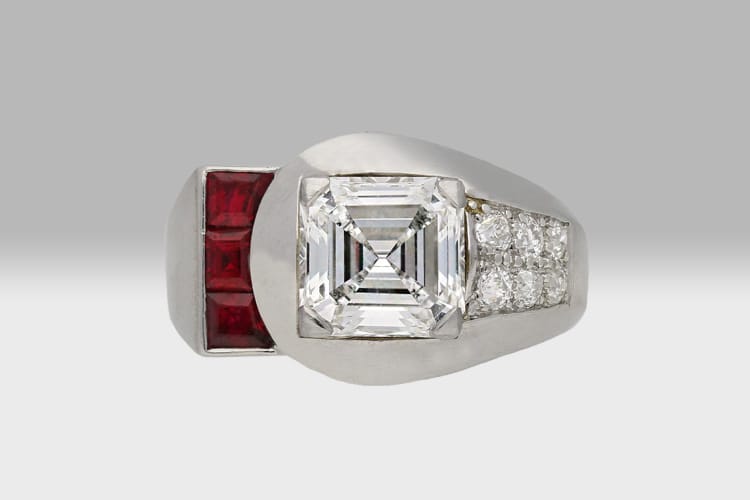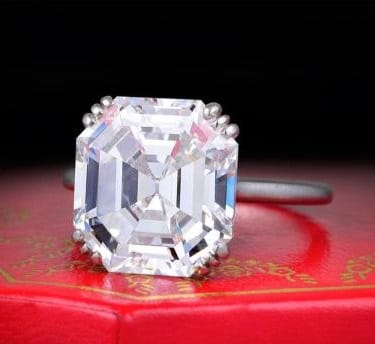The Allure of Asscher Cuts

There are a number of very enchanting antique and vintage cut diamonds that we all know and love – old miners, old Europeans, rose cuts and cushion cuts to name a few. But the most coveted and hardest to find is the Asscher cut diamond – mostly because a limited number were cut in the early 20th century before production ceased. The story of the famed Asscher cut can be traced back to the Asscher family in Amsterdam in the mid 1800s.
The company was founded by Joseph Isaac Asscher in 1854 as IJ Asscher Diamond Company. As the years progressed, Joseph Isaac’s sons – Joseph and Abraham – came into the business and changed the name of the firm to the Asscher Diamond Company. The firm became one of the most prominent diamond cutting businesses in the world. By the turn of the century and early 1900s, Amsterdam was the preeminent global diamond cutting center teeming with cutters and business. And the Asscher family was at the center of it all.
Famous Diamonds
In 1903, Abraham Asscher was tapped to cut the Excelsior Diamond, which at 995-carats was the world’s largest diamond at the time. Discovered in 1893, the diamond languished in a vault for ten years due to some legal issues. When it finally came out of the vault, the diamond was cut into 11 stones, three of which were purchased by Tiffany & Co.
A couple of years later in 1905, the Excelsior’s place as the largest diamond was usurped by the Cullinan which weighed in at an astounding 3,106-carats. The Cullinan diamond was given to King Edward VII, in 1907 as a birthday gift from South Africa’s Transvaal Colony government. King Edward sought the advice of Joseph Asscher on how to best cut the diamond. After much studying and the development of some new tools to cut the diamond, Joseph Asscher cut the rock in 1908. Nine of the polished gems were presented to King Edward and remain in the British Crown Jewels today – The Great Star of Africa and the Smaller Star of Africa were the two largest. The remaining 96 smaller stones stayed with the Asscher Diamond Company as payment for services.
The Asscher Cut Debuts
In 1902, Joseph Isaac’s grandson, also named Joseph, cut the first diamonds that would bear the family name. The Asscher cut was very different from other cuts of the era which tended to be more round and curvy. The Asscher broke with tradition and was a square, with cut corners that created an octagonal shape giving it a distinctly different look and feel from other diamond cuts that were already available. The cut was so unique that Joseph Asscher had it patented, making it the world’s first patented diamond cut.

Asscher Cut diamond, 8.06-carats, E/VVS2, set in platinum, signed Cartier Paris, courtesy Richard Buonomo.
Its square shape is not the only trait that sets the Asscher cut apart from other diamonds. It was also the extraordinary sparkle of the stone that comes from the cut corners that allow more light return in the diamond. The Asscher cut is similar to an emerald cut in that they are both step cuts, however an emerald cut is rectangular. The Asscher is distinguished by 58 facets, with a high, two-step crown and a deep pavilion. When you look straight down into the diamond from the top, you will see an “X” that is formed by equidistant converging facets, earning the cut the nickname “hall of mirrors” for the amazing light reflection in the stone.
Art Deco era jewelers were enthralled by the Asscher cut and it became one of the most important diamond cuts of the day. Its square shape was new and modern at the time and its linear architectural form was the perfect complement to the straight geometric lines of the jewelry that was being made in the 1920s and 1930s. The Asscher Diamond Company was thriving.
The End and a New Beginning
When World War II ravaged Europe, the Nazis invaded Holland, stormed Amsterdam and arrested the Asscher family and most of the few hundred employees at the company, all of whom were sent to concentration camps. At the end of the war, ten surviving members of the Asscher family returned to Amsterdam as did about 15 of their cutters. The city’s diamond industry had been gutted.
The Asscher family resolved to rebuild their business. And they did, but they stopped cutting the original Asscher. In 1980 the firm was given the Dutch Royal Predicate from Queen Juliana of the Netherlands. The company changed its name to the Royal Asscher Diamond company. A number of years later the firm introduced the Royal Asscher cut, designed by Joseph Asscher’s great grandnephews, Edward and Joop, which was based on the original cut. Sixteen more facets were added to the design for a total of 74 facets that give the diamond extra shimmer.
The firm continues to cut diamonds today with the fifth and sixth generations of the family at the helm, operating at Tolstraat 127, Amsterdam, the same building where the company started in 1854.
Source: Authored by Amber Michelle for the International Antique Jewelers Association. Featured image (top of page):Asscher Cut diamond, 1.87-carats, F/VS2, set in platinum with diamonds and natural Burmese rubies, signed Yard, circa 1935, courtesy Berganza Limited.